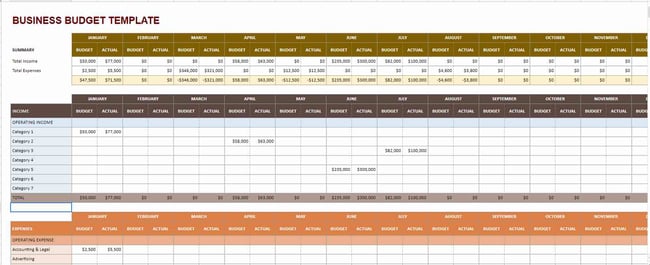Business budgets are a source of truth for your income and expenses. That includes all the money you spend — from A/B testing your marketing campaigns to your monthly office rent.
While organizing the numbers may sound difficult, using a business budget template makes the process simple. Plus, there are thousands of business budget templates for you to choose from.
We’ll share seven budget templates that can help organize your finances. But first, you’ll learn how to create a business budget.
What is a Business Budget?
A business budget is a spending plan that estimates the revenue and expenses of a business for a period of time, typically monthly, quarterly, or yearly.
The business budget follows a set template, which you can fill in with estimated revenues, plus any recurring or expected business expenses.
For example, if you run a digital marketing business, you might know that you typically make about $10,000 for your work creating campaigns, plus an extra $5,000 for your digital courses. You’d list the estimated revenue from all of your business’ revenue streams as incoming money for the business.
Then, you have your recurring expenses, which you would list as outgoing money. This could include employee salaries, office expenses, and software and technology costs.

How to Create a Business Budget
While creating a business budget can be straightforward, the process may be more complex for larger companies with multiple revenue streams and expenses.
No matter the size of your business, here are the basic steps to creating a business budget.
1. Find a template, or make a spreadsheet.
There are many free or paid budget templates online. You can start with an already existing budget template. We list a few helpful templates below.
You may also opt to make a spreadsheet with custom rows and columns based on your business.
2. Fill in revenues.
Once you have your template, start by listing all the sources of your business’ income. With a budget, you’re planning for the future, so you’ll also need to forecast revenue streams based on previous months or years. For a new small business budget, you’ll rely on your market research to estimate early revenue for your company.
3. Subtract fixed costs for the time period.
Fixed costs are the recurring costs you have during each month, quarter, or year. Examples include insurance, rent for office space, website hosting, and internet.
4. Consider variable costs.
Variable costs will change from time to time. Examples include utility bills, advertising costs, office supplies, and new software or technology. You may always need to pay some variable costs, like utility bills. You can shift how much you spend toward other expenses, like advertising costs, when you have a lower-than-average estimated income.
5. Set aside time for business budget planning.
Unexpected expenses might come up, or you might want to save to expand your business. Either way, review your budget after including all expenses, fixed costs, and variable costs. Once completed, you can determine how much money you can save.
It’s wise to create multiple savings accounts. One should be used for emergencies. The other holds money that can be spent on the business to drive growth.
How to Manage a Business Budget
There are a few key components to managing a healthy business budget.
Budget Preparation
The process all starts with properly preparing and planning the budget at the beginning of each month, quarter, or year. You can also create multiple budgets, some short-term and some long-term. During this stage, you will also set spending limits and create a system to regularly monitor the budget.
Budget Monitoring
In larger businesses, you might delegate budget tracking to multiple supervisors. But even if you’re a one-person show, keep a close eye on your budget. That means setting a time in your schedule each day or week to review the budget and track actual income and expenses. Be sure to compare the actual numbers to the estimates.
Budget Forecasting
With regular budget tracking, you always know how your business is doing. Check in regularly to determine how you are doing in terms of revenue and where you have losses. Find where you can minimize expenses and how you can move more money into savings.
Why is a Budget Important for a Business?
A budget is crucial for businesses. Without one, you could easily be drowning in expenses or unexpected costs.
The business budget helps with several operations. You can use a business budget to keep track of your finances, save money to help you grow the business or pay bonuses in the future, and prepare for unexpected expenses or emergencies.
You can also review your budget to determine when to take the next leap for your business. For example, you might be dreaming of a larger office building or the latest software, but you want to make sure you have a healthy net revenue before you make the purchase.
Create a Business Budget to Help Your Company Grow
Making your first business budget can be daunting, especially if you have several revenue streams and expenses. Using a budget template can make getting started easy. And, once you get it set up, these templates are simple to replicate.
With little planning and regular monitoring, you can plan for the future of your business.
Editor’s note: This post was originally published in September 2021 and has been updated for comprehensiveness.




